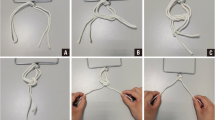Abstract
The key to obtaining an aesthetically pleasing scar is to achieve sound and secure wound apposition with minimal tension across the sutured wound. In lengthy wounds, secure wound apposition using the subcuticlar approach may be challenging, and wound breakdown in the post-operative phase is not an uncommon complication. To provide a solution to this problem, we describe a simple and practical suturing technique that approximates the wound effectively and in a secure manner to produce greater tensile strength without compromising the ideals of achieving a cosmetically pleasing scar. The authors have observed a significantly improved cosmetic result using this approach. This technique offers a consistent, simple and quick solution to closing wounds securely with an excellent cosmetic result.


Similar content being viewed by others
References
Halsted WS (1889) The radical cure of hernia: Johns Hopkins Hospital. Bulletin 1:12
Davis JS (1919) Plastic surgery, principles, and practice. P. Blakiston, Philadelphia
Thorne CH (2007) Techniques and principles in plastic surgery. In: Grabb and Smith's plastics, 6th edn. Wolters Kluwer Health/Lippincott Williams & Wilkins, Philadelphia, pp 5–6
Singh-Ranger D (2003) A simple technique for the retention of a subcuticular suture. Surg J R Coll Surg Edinb Irel 1:149–51
Huang L (2010) The backing out subcuticular suture. Br J Oral Maxillofac Surg. doi:10.1016/j.bjoms.2010.11.005
Ahmed AM, Orengo I (2007) Alternate method of loading needle to facilitate subcuticular suturing. J Am Acad Dermatol 56:S105–6
Mashhadi SA, Loh CY (2010) Subcuticular suture—is it a misnomer? Eur J Plast Surg 33:233
de Waard J, Trimbos B, Peters L (2006) Cosmetic results of lower midline abdominal incision: Donati stitches versus a continuous intracutaneous suture in a randomized clinical trial. Acta Obstet Gynecol Scand 85(8):955–959
Shaw A, Duthie GS (1995) A simple assessment of surgical sutures and knots. J R Coll Surg Edinb 40:388–91
Stott PM, Ripley LG, Lavelle MA (2007) The ultimate Aberdeen knot. Ann R Coll Surg Engl 89:713–7
Straith RE, Lawson JM, Hipps CJ (1961) The subcuticular suture. Postgrad Med 29:164–173
Durai R, Ng P (2009) Subcuticular stitch: a review of various methods. Br J Hosp Med (Lond) 70(5):M74–6
Conflicts of interest
None.
Author information
Authors and Affiliations
Corresponding author
Rights and permissions
About this article
Cite this article
Hussain, M.A., Chan, Q. & Klaassen, M. Modified technique of securing the running subcuticular suture with the Aberdeen knot in wound apposition. Eur J Plast Surg 35, 465–467 (2012). https://doi.org/10.1007/s00238-011-0670-2
Received:
Accepted:
Published:
Issue Date:
DOI: https://doi.org/10.1007/s00238-011-0670-2




